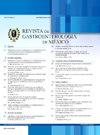Validación de la prueba de denominación de animales para el diagnóstico de la encefalopatía hepática mínima
IF 1.5
Q3 GASTROENTEROLOGY & HEPATOLOGY
引用次数: 0
Abstract
Introduction and aim
The diagnosis of minimal hepatic encephalopathy (MHE) is complex in clinical practice, given that its adequate evaluation is time-consuming. The animal naming test (ANT1) has proven to be a useful tool for rapid MHE identification. Our aim was to validate the ANT1 in a cohort of Mexican patients with cirrhosis of the liver.
Material and methods
An observational, cross-sectional, and analytic study was conducted within the time frame of June 2022 and May 2023. MHE diagnosis was made using the psychometric hepatic encephalopathy score (PHES). Patients with overt HE evaluated through the West Haven criteria were excluded. The ANT1 was performed on all participants.
Results
A total of 199 patients with cirrhosis and 31 non-cirrhotic control subjects were analyzed. Women predominated (61.8% and 71%) and mean patient age was 55 ± 10 and 53.6 ± 12 (range 19 to 84 years), respectively. Ninety patients (45.2%) met the MHE criteria determined by the PHES. Using an ANT1 cutoff point of ≤ 15, MHE was identified in 65 (32.7%) patients, along with 75% sensitivity, 72% specificity, 53% positive predictive value, 87% negative predictive value, and 73% diagnostic accuracy. The area under the curve for diagnosing MHE was 0.763 (standard error, 0.081; 95% confidence interval, 0.604-0.923; p ≤ 0.0001).
Conclusions
The ANT1 was shown to be a useful tool for identifying MHE in daily clinical practice. In our population, a cutoff point ≤ 15 animals named could be utilized for rapid screening of patients at high risk for progressing to overt HE, who would then require extensive testing.
验证动物命名试验以诊断轻度肝性脑病
简介与目的在临床实践中,诊断轻度肝性脑病(MHE)是复杂的,因为它的充分评估是费时的。动物命名试验(ANT1)已被证明是快速鉴定MHE的有用工具。我们的目的是在一组墨西哥肝硬化患者中验证ANT1。材料和方法在2022年6月至2023年5月期间进行了一项观察性、横断面和分析性研究。MHE诊断采用肝性脑病心理测量评分(PHES)。通过West Haven标准评估的明显HE患者被排除在外。对所有参与者进行ANT1检查。结果共分析199例肝硬化患者和31例非肝硬化对照组。女性占多数(61.8%和71%),患者平均年龄分别为55±10岁和53.6±12岁(范围19至84岁)。90例患者(45.2%)符合PHES确定的MHE标准。采用ANT1截断点≤15,65例(32.7%)患者被诊断出MHE,其敏感性为75%,特异性为72%,阳性预测值为53%,阴性预测值为87%,诊断准确率为73%。诊断MHE的曲线下面积为0.763(标准误差0.081;95%置信区间为0.604-0.923;p≤0.0001)。结论在临床实践中,ANT1是鉴别MHE的有效工具。在我们的人群中,截断点≤15只动物可以用于快速筛选进展为显性HE的高风险患者,然后需要进行广泛的检测。
本文章由计算机程序翻译,如有差异,请以英文原文为准。
求助全文
约1分钟内获得全文
求助全文
来源期刊

Revista de Gastroenterologia de Mexico
GASTROENTEROLOGY & HEPATOLOGY-
CiteScore
1.60
自引率
12.50%
发文量
102
审稿时长
12 weeks
期刊介绍:
La Revista de Gastroenterología de México es el órgano oficial de la Asociación Mexicana de Gastroenterología. Sus espacios están abiertos a los miembros de la Asociación como a todo miembro de la comunidad médica que manifieste interés por utilizar este foro para publicar sus trabajos, cumpliendo con las políticas editoriales que a continuación se mencionan. El objetivo principal de la Revista de Gastroenterología de México, es publicar trabajos originales del amplio campo de la gastroenterología, así como proporcionar información actualizada y relevante para el área de la especialidad y áreas afines. Los trabajos científicos incluyen las áreas de Gastroenterología clínica, endoscópica, quirúrgica y pediátrica.
 求助内容:
求助内容: 应助结果提醒方式:
应助结果提醒方式:


